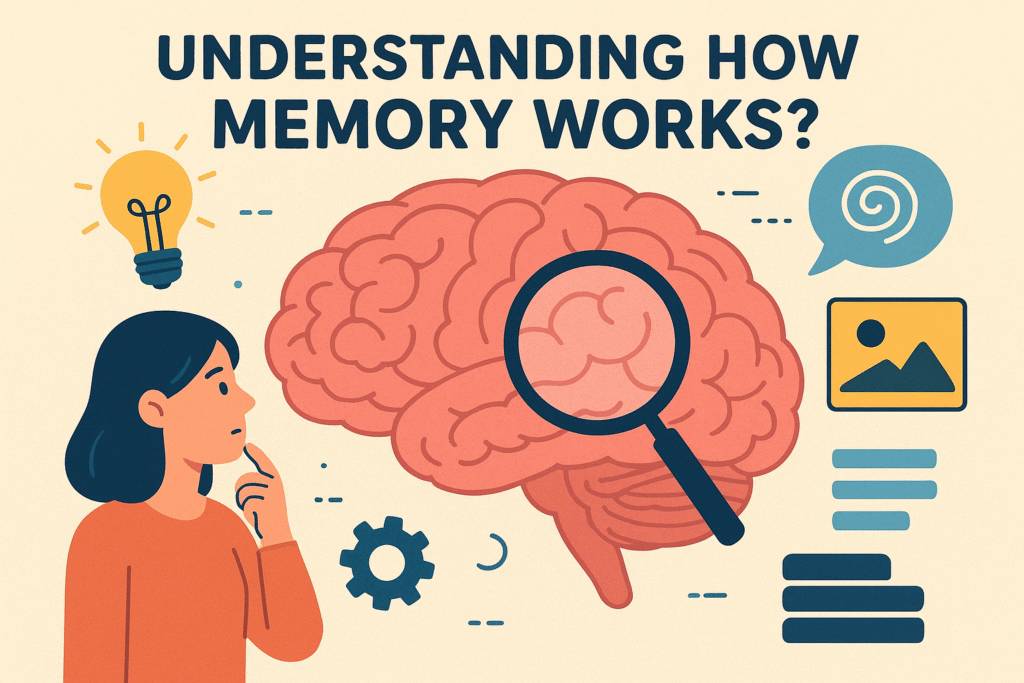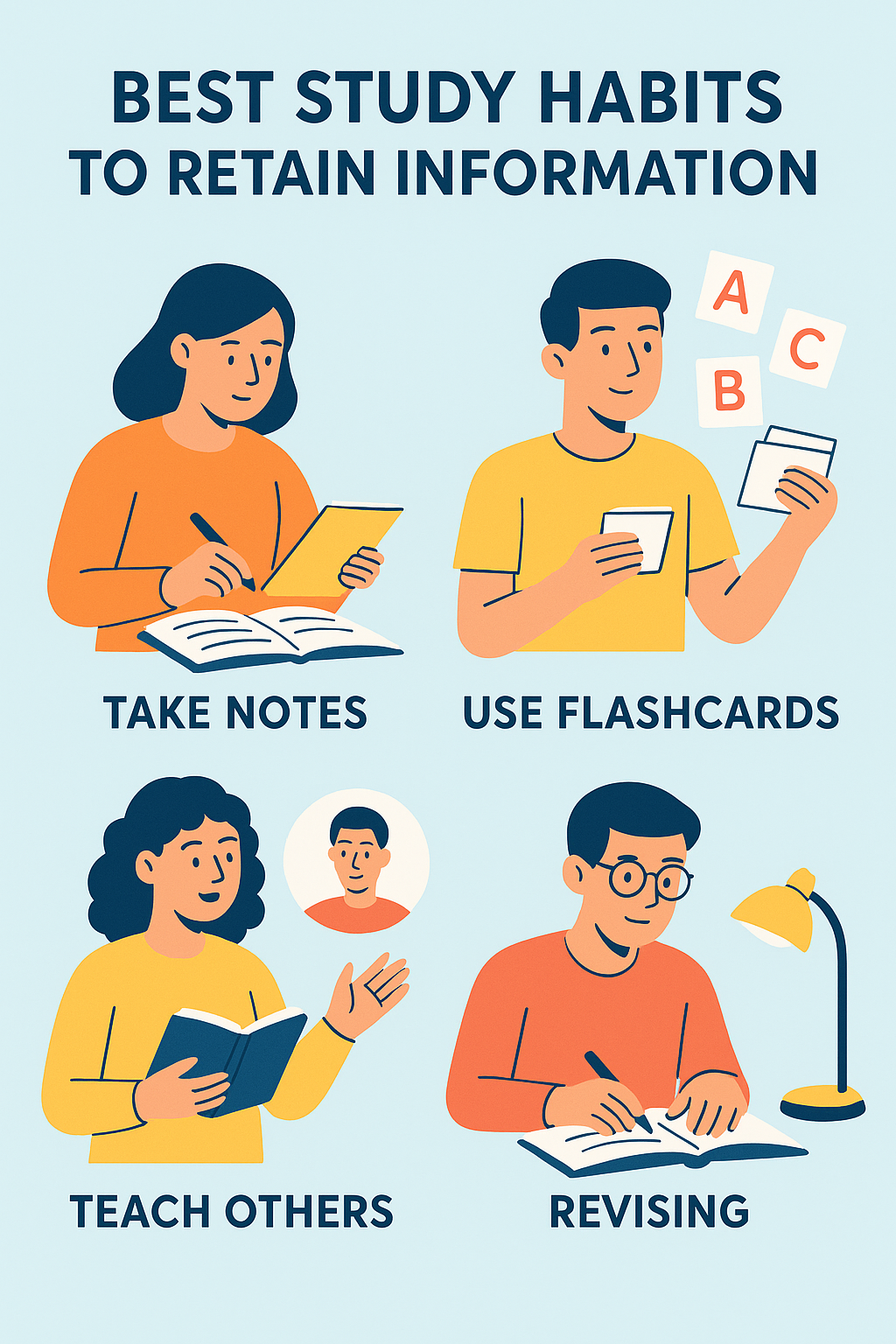Retaining Information impacts how we learn, make decisions, quickly answer any question, and function in daily life. If we don’t retain any information, everything we study or experience will fade away, and it will make your learning useless. Retaining information makes us great problem solvers through experiences and knowledge; through this, we can analyze situations and take decisions effectively. It plays a major role in skill building and refining skills, whether it is driving, coding, cooking, or dancing in everything. Beyond that it is helpful in personal growth and career success by shaping our values, beliefs and wisdom.
Table of Contents
Understanding How Memory Works?

There are two major factors, retention and repetition, which influence the memory retention continuously. Repetition provide strengths to the neural connections in the brain, which makes it easier to retrieve information after a short period of time. Like Reviewing vocabulary words every day or solving some similar math problems repeatedly helps to store them in long-term memory. Sometime context also plays a major role like the environment, timing, and method of learning can affect how efficiently information is recalled.
Memory is divided into two types, short term and long term memory, each serves for different purpose. Short term memory (STM) holds information for a brief period, from a few seconds to a few minutes. It has very limited capacity and fades quickly if it is not used actively. For example – Remembering a phone number which is long enough to dial it. Long term memory (LTM) stores information for hours, days, or a lifetime. To move the information from STM to LTM, requires reinforcement, active engagement, practice, continuous learning and association. For example – Understanding math concept deeply, so you can use or recall it after few months.
Best Study Habits To Retain Information
Active Learning: Instead of just reading, try to engage with the study material with focus. Summarize the things in your own words, explain them to anyone, or try to teach the concept to others. Because when you process the information in your own words, it becomes deeper and more profound. After reading every paragraph, try to summarize in your own words and after every 5–10 minutes, try to teach an imaginary student. Make questions on that paragraph like “why?”, “how?”, and “what if…?” and write their answers.
Spaced Repetition: Review your material time to time like (day0 → day1 → day4 → week2 …). This helps to save us from forgetting curve and every review increase our memory strength. Cramming, the method of memorizing everything in one day, may work for the short-term, but it’s not useful for long-term memory. Spaced repetition means that you revise the same thing at regular intervals—like after a day, then after 3 days, after a week, and then after a month. This technique beats the forgetting curve and keeps the information in the brain for a longer time.
Practice Testing: keep testing yourself regularly, and by doing quizzes, past papers, or using flashcards, you can strengthen your memory. Testing yourself is a repeated practice that directly improves your ability to remember. After every chapter, make at least 5–10 questions and try to answer them without looking at the book. Solve practice papers or mock tests, and whenever you make a mistake, note that error carefully so you don’t repeat it again.
Use Multiple Sense: While reading, use your multiple senses for better learning. Try to understand by speaking out loud, listen carefully to the visuals, and engage with the material as if Multi-sensory encoding creates different retrieval notes—making the recall easier. Write important formulas by hand, recite short notes, and show diagrams or charts to reinforce concepts.
Study in context: Now it is even more important to connect what we have already read with new information. To increase our retention power, we should use a linked information network, which creates a very stable memory—like connecting each idea to related concepts we already know.
Mind Mapping: To remember a lot of information, we should use visual tools like mind maps, flow charts and diagrams which are very helpful in increasing our retention power. They give us a clear structure, and we can understand the entire topic on a single page because of this. For example, you are reading a chapter of biology and make a process flowchart of it, when you explain it through a map, your understanding becomes clearer and our memory improves.
Avoid Cramming: We should not study for too long without any break, it reduces our concentration. A better approach is to follow the Pomodoro technique. Like study for 25 to 30 minutes with intense focus and then take a break for 5 minutes. After four cycles take a long break and this will keep your mind fresh, and you will be able to focus on your learning and your retention power will increase.
Stay Healthy: Health directly affects our memory, so for this we should take proper sleep, exercise and follow a healthy diet which is very important for our health. Sleep also has a huge impact on our brain, so we should take proper sleep to increase long term memory. If we stay awake at night or eat junk food, then there are high chances of our learning and retention power getting reduced, so we should stay away from junk food and sleep deprivation.
Right Environment: The most important thing for studying is a distraction-free environment. So firstly, create a distraction-free environment, like turn off mobile notifications, make a fixed study spot where you sit and study there only, and also take care of light and comfort. Whereas, when you study at one place, your brain associates that environment with study, due to which you get the focus quickly.
Review Before Sleep: Always take a quick review of 10–15 minutes before going to sleep because during sleep the brain consolidates the recently learned material, that shifts the information into long term memory, hence bedtime revision is very helpful to increase memory retention power, just avoid heavyweight new topics and read only recently studied topics.
What is the 1/2/3 method for studying?
The 1/2/3 method is a very simple and effective method that helps us retain information for a long time. It involves review a new topic into multiple stages at different times. Here are the stages:
- First Review (1): The benefit is to review the information immediately after the first time you learn it, to transfer the information from short term memory to working memory. During this review, don’t just read—try to explain it in your own words.
- Second Review (2): After a few hours or the next day, return to the second review of the same material. This will improve your memory and help you identify areas where your understanding is weak.
- Third Review (3): The third review is done after a few days or weeks. This review helps transfer information from short-term memory to long-term memory, making it more permanent and less likely to be forgotten quickly. During this stage, you should do a full review and focus on any difficulties you encountered in the previous two reviews.
What is the 7-3-2-1 study method?
7-3-2-1 This study method is an effective way of studying which helps us to focus and remember the information for a long time. With this method, we can divide any topic into four stages.
First, spend 7 minutes reading and understanding the topic. During this time, focus only on explaining the main ideas and concepts and try to connect the new knowledge with the already known knowledge. After this, do a 3-minute review in which we highlight the important points or formulas and ask ourselves what is most important in it and how it is related to other information.
Take 2 minutes for active recall, during which you should close your book and write down in your own words everything you have learned and understood so far. Try to create diagrams, visualize the concepts, and mentally connect ideas. This step is extremely important for long-term memory and is highly effective in strengthening retention.
Finally, in the last 1 minute, review everything you have studied so far and focus on understanding it deeply so that it can be remembered for a long time. In this way, the method can be divided into four steps: studying, reviewing, active recall, and summarization. This structured approach helps the information get absorbed gradually and more effectively.

